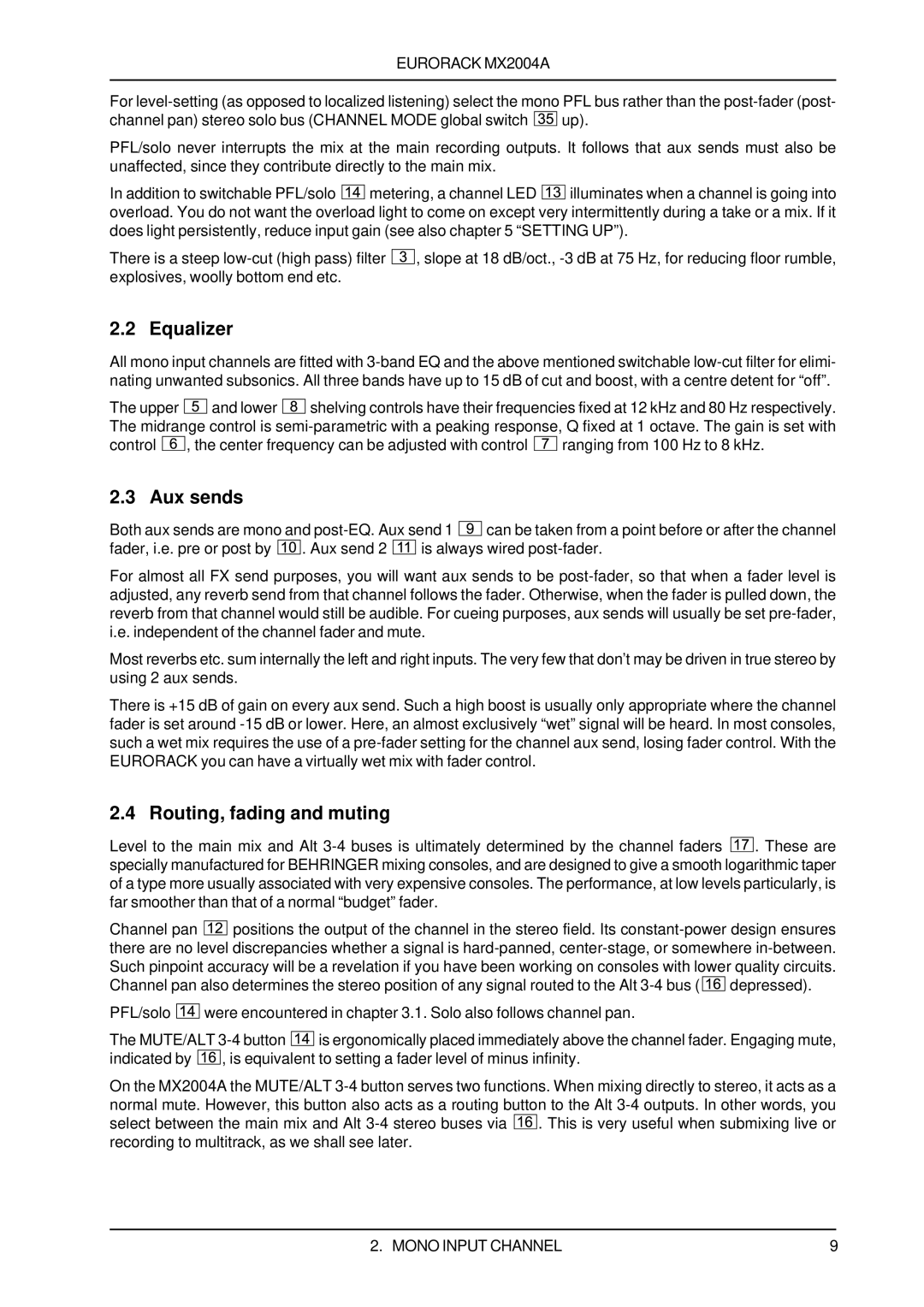
EURORACK MX2004A
For
channel pan) stereo solo bus (CHANNEL MODE global switch ![]()
![]()
![]() up).
up).
PFL/solo never interrupts the mix at the main recording outputs. It follows that aux sends must also be unaffected, since they contribute directly to the main mix.
In addition to switchable PFL/solo ![]()
![]()
![]() metering, a channel LED
metering, a channel LED ![]()
![]()
![]()
![]() illuminates when a channel is going into overload. You do not want the overload light to come on except very intermittently during a take or a mix. If it does light persistently, reduce input gain (see also chapter 5 “SETTING UP”).
illuminates when a channel is going into overload. You do not want the overload light to come on except very intermittently during a take or a mix. If it does light persistently, reduce input gain (see also chapter 5 “SETTING UP”).
There is a steep ![]()
![]()
![]() , slope at 18 dB/oct.,
, slope at 18 dB/oct.,
2.2 Equalizer
All mono input channels are fitted with
The upper ![]()
![]()
![]() and lower
and lower ![]()
![]()
![]() shelving controls have their frequencies fixed at 12 kHz and 80 Hz respectively. The midrange control is
shelving controls have their frequencies fixed at 12 kHz and 80 Hz respectively. The midrange control is
control ![]()
![]()
![]() , the center frequency can be adjusted with control
, the center frequency can be adjusted with control ![]()
![]()
![]() ranging from 100 Hz to 8 kHz.
ranging from 100 Hz to 8 kHz.
2.3 Aux sends
Both aux sends are mono and ![]()
![]()
![]() can be taken from a point before or after the channel
can be taken from a point before or after the channel
fader, i.e. pre or post by ![]()
![]()
![]()
![]() . Aux send 2
. Aux send 2 ![]()
![]()
![]()
![]() is always wired
is always wired
For almost all FX send purposes, you will want aux sends to be
Most reverbs etc. sum internally the left and right inputs. The very few that don’t may be driven in true stereo by using 2 aux sends.
There is +15 dB of gain on every aux send. Such a high boost is usually only appropriate where the channel fader is set around
2.4 Routing, fading and muting
Level to the main mix and Alt ![]()
![]()
![]()
![]() . These are specially manufactured for BEHRINGER mixing consoles, and are designed to give a smooth logarithmic taper of a type more usually associated with very expensive consoles. The performance, at low levels particularly, is far smoother than that of a normal “budget” fader.
. These are specially manufactured for BEHRINGER mixing consoles, and are designed to give a smooth logarithmic taper of a type more usually associated with very expensive consoles. The performance, at low levels particularly, is far smoother than that of a normal “budget” fader.
Channel pan ![]()
![]()
![]()
![]() positions the output of the channel in the stereo field. Its
positions the output of the channel in the stereo field. Its ![]()
![]()
![]()
![]() depressed).
depressed).
PFL/solo ![]()
![]()
![]()
![]() were encountered in chapter 3.1. Solo also follows channel pan.
were encountered in chapter 3.1. Solo also follows channel pan.
The MUTE/ALT ![]()
![]()
![]()
![]() is ergonomically placed immediately above the channel fader. Engaging mute, indicated by
is ergonomically placed immediately above the channel fader. Engaging mute, indicated by ![]()
![]()
![]()
![]() , is equivalent to setting a fader level of minus infinity.
, is equivalent to setting a fader level of minus infinity.
On the MX2004A the MUTE/ALT ![]()
![]()
![]()
![]() . This is very useful when submixing live or recording to multitrack, as we shall see later.
. This is very useful when submixing live or recording to multitrack, as we shall see later.
2. MONO INPUT CHANNEL | 9 |
